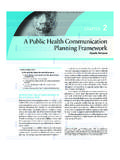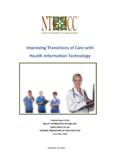Transcription of The five-Star Doctor - who.int
1 1 THE five-Star Doctor : An asset to health care reform? Dr Charles Boelen World health Organization, Geneva, Switzerland Defining universal challenges in health reform is itself a challenge, let alone proposing appropriate responses to such challenges. We hope to avoid the risks inherent in such generalization by focusing on some major changes that would lead to the adequate provision of health care to all. Although the spectrum of causes of death, disease and disability that hinder an enjoyable and productive life varies considerably with environment, socioeconomic context and demography, we will try to identify determinants valid in any health care delivery system. In much of the world, both health care beneficiaries and those who plan, finance and provide health care are increasingly aware of the need to reform health care systems but have very different priorities and expectations.
2 For example, consumers primarily want high-quality health services in adequate quantity; health professionals want to expand their knowledge base and exercise independent judgment in providing the best possible care; and health care policy-makers want care for all citizens that is cost-effective. SHARING VISION on CHALLENGES in health REFORM For a health care system to make the necessary changes and run efficiently, however, the main stakeholders must decide to work together and must agree on a set of fundamental values. Relevance, quality, cost-effectiveness and equity are values implicit in the goal of health for all, endorsed by all nations and governments, which offers such a basis. The 2 stakeholders policy-makers, health system managers, researchers, care providers, educators and consumers alike must re-examine their position on the health chessboard and consider readjusting their expectations to ensure that these values are upheld and people s health needs are better met.
3 It is in this context that the future role of health professionals, and in particular, the medical Doctor , should be thought of. Relevance: Relevance in health care can be defined as the degree to which the most important problems are tackled first. Although priorities may be interpreted in different ways in different societies or by different groups within the same society, primary attention should be given to those who suffer most, to ailments that are most prevalent, and to conditions that can be addressed with locally available means. It is fundamental that health policy reflect these priorities. Relevance also implies an organized effort to constantly update a plan to address the priority health needs. Certain aspects of relevance may be considered universal. As articulated in the Declaration of Alma-Ata1, these include issues of universal access, primary health care services, essential public health services and availability of essential drugs.
4 Quality: High-quality health care uses evidence-based data and appropriate technology to deliver comprehensive health care to individuals and populations, taking into account their social, cultural and consumer expectations. WHO s definition of health as a state of complete physical, mental and social well-being and not merely the absence of disease or infirmity should be a beacon for health care reformers and communities. The quest for high-quality care is universal, but the definition of quality may differ with sociocultural context. Also, what is good can no longer be determined solely by the professionals and institutions that deliver the goods and services. Consumers expect health services to be comprehensive, continuous and 1 Alma-Ata 1978: primary health care.
5 Report of the International Conference on Primary health Care, Alma-Ata, USSR, 6 12 September 1978. Jointly sponsored by the World health Organization and the United Nations Children s Fund. Geneva, World health Organization, 1978 (WHO health for All Series, No. 1). 3personalized to respond to their specific needs for well-being. High quality in health care must therefore encompass the technical criteria set by health care providers and the comfort criteria set by health care consumers. Cost-effectiveness: The rise in health care costs is due to universally observed phenomena: specialization in health care, which implies the use of costly procedures; increased access to health services due to sociodemographic changes; increased demand from individual consumers as expectations for a better quality of life result from wider access to information.
6 As these phenomena will persist and even be amplified in the future in any society, all health policy-makers and health care providers concerned with the health reform process must give urgent attention to the containment of cost without compromising effectiveness in health care. This issue is all the more urgent as governments, under socioeconomic pressure to invest preferentially in more wealth-producing sectors, allot no increase in health budgets; in many countries, health budgets are decreasing even as the health status of the people is deteriorating. Cost-effective health care systems are those that have the greatest positive impact on the health of a society while making the best use of its resources. Whatever the level of resources available, cost-effective care can be provided. Equity: Equity, which is central to a socially accountable health care system, means striving towards making high-quality health care available to all.
7 The central goal of the WHO Global Strategy for health for All is that all people receive at least such a level of health that they are capable of working productively and of participating actively in the social life of the community in which they live. To attain such a level of health , every individual should have access to primary health care and through it to all levels of a comprehensive health system. 2 Equity means that people s needs, rather than social privileges, guide the distribution of opportunities for 2 Global Strategy for health for All by the Year 2000. Geneva, World health Organization, 1981. 3 Equity in health and health care: a WHO/SIDA initiative. Geneva, World health Organization, 1996 (unpublished document WHO/ ; available on request from Division of Analysis, Research and Assessment, World health Organization, 1211 Geneva 27, 4 Switzerland).
8 The quest for relevance, quality, cost-effectiveness and equity is universal. Societies at every level of socioeconomic development seem to adhere to the same fundamental principles. Attaining each of these values is indeed a challenge for health reformers, but even more demanding is the need to address this challenge in a balanced way. Figure 1 depicts these four values plotted on a diagram, analogous to a compass. The crossing of the axes is the lowest point and the extremities of the axes are the optimal points on the scale of values. This health compass represents an ideal health care system that is attempting to meet the needs of individuals and populations. 5 Figure 1. The health compass The compass analogy may not seem appropriate, as it implies the need to choose and maintain a direction, whereas in the case of health reform it should not be necessary to choose one value at the expense of others.
9 But the compass analogy shows the tensions that exist in a health reform process that aims at finding technically appropriate and socially acceptable compromises among all values at the same time. In our view, the essence of the responses to challenges in health reform lies in reducing the conflict of interests among the different stakeholders in each of the four principles, in order to release tension and find a modus operandi that permits approaches based on these principles to evolve to full bloom. THE EMERGENCE of the five-Star Doctor The optimal model of health service delivery may be one that contributes to the convergence of different inputs towards the satisfaction of the values of relevance, quality, cost-effectiveness and equity in health . Innovative thinking and courageous attempts must be made to counteract the galloping fragmentation of the health care delivery system, which is characterized by at least three splits (see figure 2): the first is the relative isolation of individual care from population-based care, or in other words, the split between medicine and public health (A); the second is the split between generalists and specialists (A ) and the third is the split between the health sector and other sectors with a bearing on health (A ).
10 Figure 2 shows how a reconciliation of the splits could be mapped4. 4 Boelen C. From fragmentation to unity in health care: a challenging journey. Changing medical education and medical practice, June 1996:2. 6 Figure 2 Priority should be accorded to reconciling activities geared towards the health of individuals and groups and research dedicated to the design of appropriate schemes, whereby both sets of activities could be carried out in coordination and in an acceptable and cost-effective balance, either in the same health care settings or by the same health professionals. The concept of the five-Star Doctor is proposed as an ideal profile of a Doctor possessing a mix of aptitudes to carry out the range of services that health settings must deliver to meet the requirements of relevance, quality, cost-effectiveness and equity in health .

















